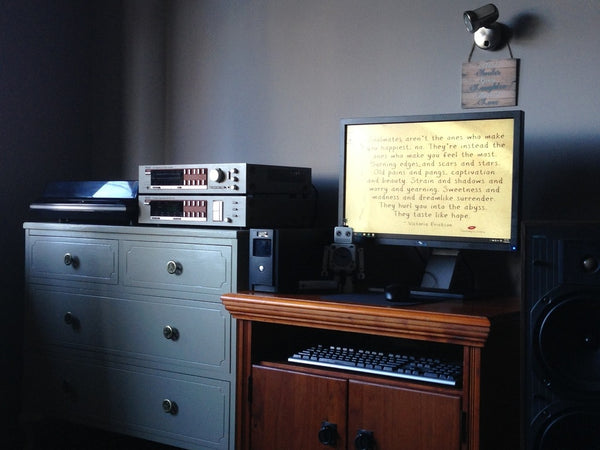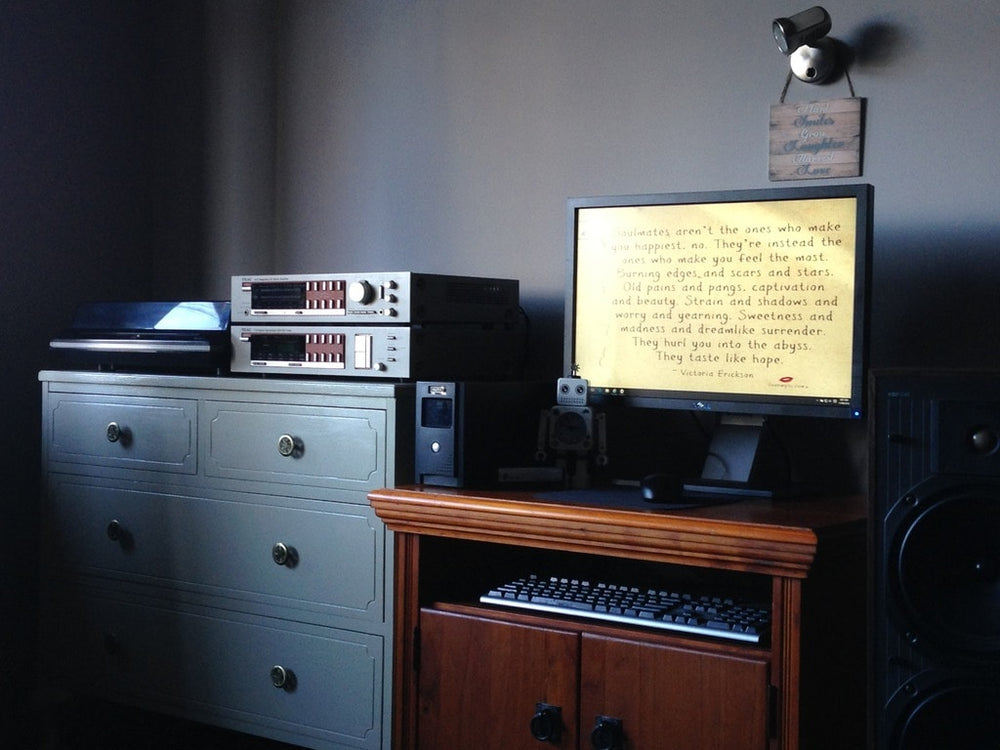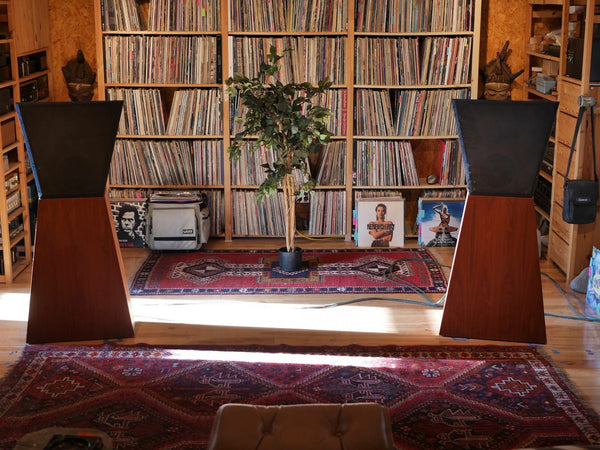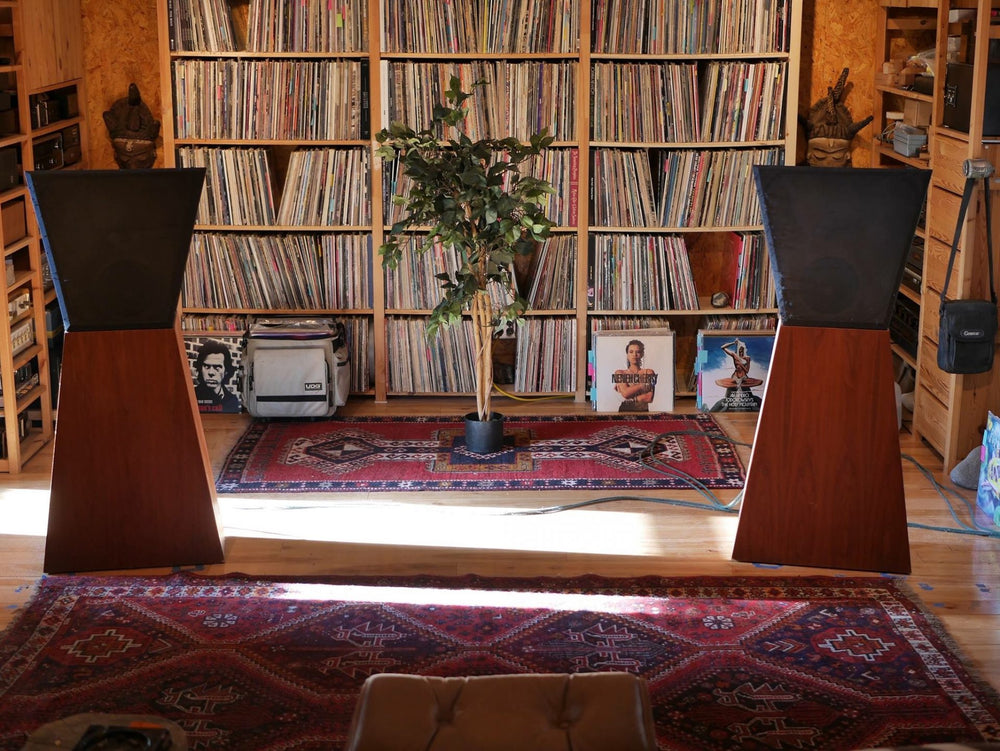[We started our look back at speaker manufacturer Spica in Copper #26, with an overview of the company’s products. In Copper #27 we began our talk with John Bau, founder and designer at Spica. In this installment, we wrap up our talk with John, and ask: is there a future for the beloved brand? —Ed.]
C: Doubling back to the period when you got started in the ’70’s and ’80’s, there was a lot of emphasis placed upon loudspeakers that were accurate in the time domain—I’m thinking of Ed Long and others—there’s always been confusion over something that was accurate in frequency response versus something that’s accurate in phase. I’m just not sure how you’d state what your goals were Spica. How would you define them [the goals of your designs]?
JB: That’s a good question, and there’s not an easy answer, because speakers are such a bag of worms…especially, trying to do a phase-align. We can make a visual analogy. Let’s pretend that sound is a fruit pie. The speaker’s job is to deliver that pie intact to the listener’s ears. A multi-way speaker system divides that pie into as many pieces as it has drivers [or crossover points], and needs to deliver those pieces as if the pie had never been cut.
Let’s say you have a two-way system, so the pie is in two separate pieces. If woofer and tweeter are mounted on a flat baffle, the pieces won’t be delivered at the same time. There’s no way to fool the listener that it’s really one pie! The crossover also modifies the delivery time further. That’s a simple analogy for what my job was, as a designer.
C: It’s a challenge.
JB: It turns out that if you have more than one driver, more than one source that you’re trying to sum, you can only sum that at one point in space….That’s just one example of how if you break down the event and understand what it takes to pull off this magic, it’s kind of like visual holography in that everything has to be set up in the right place, or the phase differences don’t work. The image is not created.
This whole thing about accurate time domain being different from accurate frequency domain and tonal response being different from the imaging—that’s all BS. They’re all the same…but you have to pay attention to the timing parameters. The closer you get to one, the more the others fall into place…but you have to optimize them all simultaneously.
C: When you think in terms of speakers that place emphasis on absolute phase, there are other companies that started about the same time you did: Thiel, Vandersteen. And yet, you’ve never stuck to single-order crossovers like they did. You had a completely different way of going about it.
JB: That’s because a single-order crossover is good in theory, for electronics—but it’s not good acoustically, because of this whole thing about the crossover overlap. With a 6 dB per octave crossover—AKA a first-order— you’ve got two drivers that are contributing to the final wavefront over a four-octave range!
Number one, the drivers that you can buy are incapable of doing that…so you’ve got to design a crossover that will enable them to do that. The fact that tweeters take a nose-dive at around 800 to 1000 Hertz just throws the viability of a pure first-order crossover out the window immediately.
One of the things that I brought into the picture from a design point of view—and I don’t know that anybody else was doing—was that I modeled the complete system AND each element of the system as electronic circuits (including time delay), created target functions for each part based on the actual responses of the drivers against what the computer said it needed to be, and then optimized the crossover and baffle design to achieve that. I wasn’t married to any particular theory, or using book formulas.
So: okay. Let’s figure out what does it take in order to get it to sum to unity magnitude and phase over this crossover region?
C: I think there’s a difference there from your approach to that of Jim or Richard. They tended to approach things from a purely theoretical viewpoint of, “this is what I want to do—now I’ve got to somehow produce drivers that will function that way.” It could be argued that they never really quite got there.
JB: Yes, first order systems are the Mecca of most speaker designers. I can guarantee you they never got there. It’s impossible. You still can’t get there. And on the way, you’ll find other serious problems have been created [by first-order lobing error].
[To some extent] we were all in over our heads with that stuff. I certainly was. When I first got exposed to…AES magazines that had all of Richard Heyser’s papers on Time-Delay Spectrometry…[I read them] for months before they started to soak in…because I wasn’t a mathematician, I wasn’t an engineer. I didn’t have any training.
C: A lot of people would say that even with that intensive level of absorption, Heyser’s papers still wouldn’t be crystal-clear. There’s been a bit of a backlash in recent years amongst math-minded folks, saying that Heyser was all wrong…
JB: Based on my experience, I totally disagree.
C: And I would expect you to, as one whose designs embodied his principles more than any speakers I’m aware of.
JB: He didn’t even start out applying this [TDS] to speaker systems. He was doing work for NASA, tracking underwater systems and systems in space, wanting to get accurate phase measurements and realized that he had to deal with the signal-path delay. Eventually, the light went on in his head—and just as a hobby, in his basement using old beat-up equipment that he modified in order to get it to work the way that he needed it to, figured out how to do it, and applied it to speakers. He did papers and they sat around for ten or more years before anyone realized what he’d done.
C: Big picture: if you were able to do it all over again—-you probably wouldn’t do it, would you? Knowing how much trouble it would be…
JB: I wouldn’t, definitely. It’s impossible for me at this point.
C: Nonetheless, I’d be interested in having you look around at what’s out there today…there is kind of a peculiar revival of two-channel things, perhaps pushed along by personal listening and the headphone drive, coupled with the revival in vinyl, as well. We pretty much missed a generation…maybe two…in terms of markets for two-channel audio.
I’d be really intrigued to see what you could come up with these days for $1000 or $2000—but I know that’s not going to happen.
JB: Yeah, it’s not. I hit a burn-out point in music. This path started for me when I was like 11 or 12 years old as a singer and then musician and songwriter and then recording engineer and that’s where my big interface with the equipment happened—so I transitioned from being a musician and recording engineer into the speaker part, and that was to fulfill a specific need. I had a need to be filled that I couldn’t fill any other way. Part of it also was, as you said, back in the late ’70’s there was great interest in this whole time-aligned stuff… even if you were pursuing that general classification of speakers, there were three or four different ways of exploring it.
Time-aligned was not phase alignment—it was just aligning voice coils! (laughs)
C: In its most basic methods, yeah.
JB: And the speaker that [Ed Long] did most of his work with was an Altec-Lansing driver with a concentric horn where the cone was part of the horn? I was like….
C: Sounds like a 604 or a 605.
JB: It was a 604E. You’ve got it. I heard them. I went to a studio and heard them, and thought, ” I wouldn’t want to record or mix on those”, although they were better than the stock ones…. my first job back then was sorting out, what do I pursue? Time alignment? Phase alignment? Impulse response? KEF had this whole thing…they got major funding from the BBC to pursue digital implementation of Heyser’s work, via impulse response. So they bought this $100,000 Hewlett-Packard mainframe computer and some really smart guys, and they figured out how to do what Heyser was doing with swept-sine, doing it with impulse response. That was the paper that really got me into it.
We had a KEF dealer in Albuquerque, so I was reading their papers and then going down to hear what they’d created on the basis of what they had learned…and they weren’t phase-aligned. They figured out how to do it right, and then they did it wrong, in production…using fourth-order networks for a high-pass function, the phase characteristics were just a bloody mess, and they found out they weren’t phase-coherent or minimum-phase at all!
But they did all the hard work and research for me.
C: That would’ve been the 104 or 105?
JB: The 105 was the one I was thinking of. They never published the phase response of the complete system. They never showed you the impulse response of the system. All they showed you were their lovely computer-derived transfer functions and the various responses of the drivers…and I think that’s when Linkwitz-Riley really came into vogue. And that’s still popular…and if you’re interested in uniform power response, that’s a good road to go down. If you’re interested in acoustic holography…It’s a mess.
Some of these principles also apply to electronics—specifically the power supplies.
C: Okay. How so?
JB: It turns out that the phase response of the power supply is just as important as the phase response of the drivers. That’s where this whole event starts—in the power supply.
I was injured on a tennis court about eight years ago, and kind of disabled for a number of months…and so I decided to reopen my audio hobby and inquiry, and ended up doing some power supply research that resulted in a patent. Then when I was done with it, that was around the time that I was totally burned out on audio, so I just dropped it.
Anyway: the phase response of the power supply and the dynamic behavior of the power supply are really, really important. It”s not just enough to have a linear-phase speaker. You also need everything else in the chain [to have linear phase].
C: John, I appreciate your time. If you ever feel the urge to write about your past work, or what could still be done in speakers, I’d certainly be interested in taking a look at it. It’s been a pleasure talking with you, John. Thanks so much for your time.
JB: Thank you, Bill. I’ve enjoyed it immensely.
[Just a reminder: almost anything you care to know about Spica can be found on the Spica Speaker Enthusiast website. It’s an amazing resource, and props to John Allen, the site’s creator.–Ed.]












